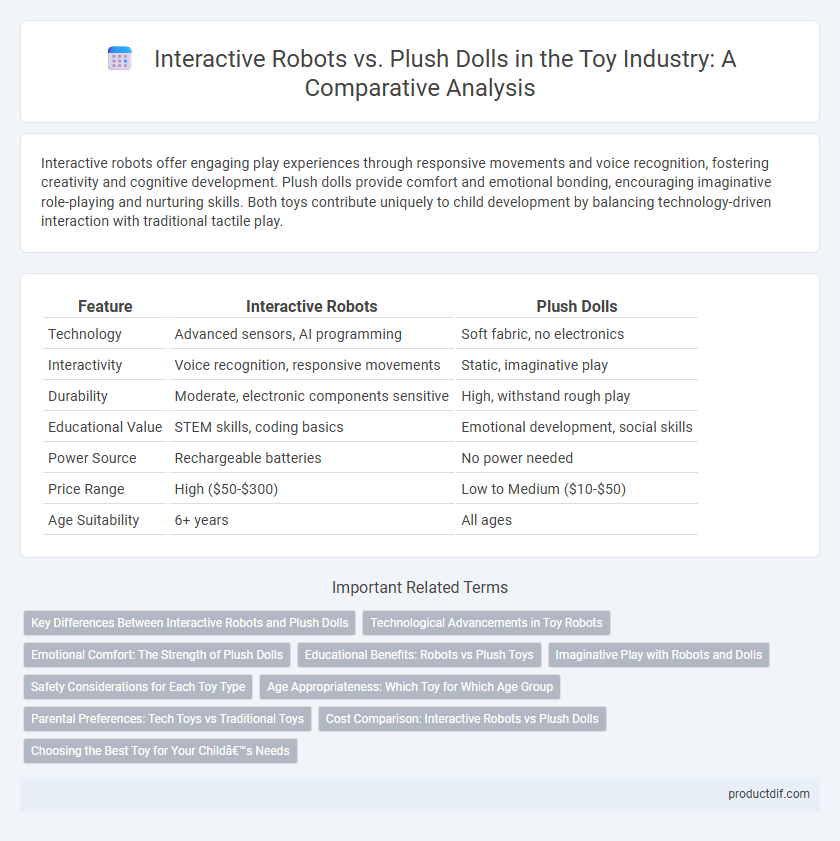Interactive robots offer engaging play experiences through responsive movements and voice recognition, fostering creativity and cognitive development. Plush dolls provide comfort and emotional bonding, encouraging imaginative role-playing and nurturing skills. Both toys contribute uniquely to child development by balancing technology-driven interaction with traditional tactile play.
Table of Comparison
| Feature | Interactive Robots | Plush Dolls |
|---|---|---|
| Technology | Advanced sensors, AI programming | Soft fabric, no electronics |
| Interactivity | Voice recognition, responsive movements | Static, imaginative play |
| Durability | Moderate, electronic components sensitive | High, withstand rough play |
| Educational Value | STEM skills, coding basics | Emotional development, social skills |
| Power Source | Rechargeable batteries | No power needed |
| Price Range | High ($50-$300) | Low to Medium ($10-$50) |
| Age Suitability | 6+ years | All ages |
Key Differences Between Interactive Robots and Plush Dolls
Interactive robots offer dynamic responses and programmable features, allowing real-time interaction through sensors and artificial intelligence, while plush dolls provide tactile comfort and imaginative play without electronic components. The key differences lie in functionality; interactive robots incorporate technology for movement and sound, enhancing engagement, whereas plush dolls emphasize softness and traditional nurturing experiences. These distinctions affect user experience, with robots appealing to tech-savvy children and plush dolls favoring those seeking companionship and sensory comfort.
Technological Advancements in Toy Robots
Interactive robots leverage cutting-edge technologies such as artificial intelligence, sensors, and machine learning to provide dynamic play experiences that adapt to a child's behavior and preferences. Unlike traditional plush dolls, these toy robots offer voice recognition, movement capabilities, and programmable features that enhance educational and entertainment value. Continuous advancements in robotics and software development enable increasingly sophisticated interactions, making toy robots a leading innovation in the children's toy market.
Emotional Comfort: The Strength of Plush Dolls
Plush dolls provide unmatched emotional comfort through their soft textures and familiar shapes, which evoke feelings of security and nostalgia in children. Unlike interactive robots that may focus on engagement and responsiveness, plush dolls offer a consistent source of tactile soothing and emotional attachment. Research shows that children often turn to plush toys during stressful moments, highlighting their role as comforting companions.
Educational Benefits: Robots vs Plush Toys
Interactive robots offer advanced educational benefits by engaging children in STEM learning through coding, problem-solving, and real-time feedback, enhancing critical thinking skills. Plush dolls primarily support emotional development and social skills by encouraging imaginative play and nurturing behavior. Both toys contribute to early childhood growth, but interactive robots provide a more dynamic and technology-driven learning experience.
Imaginative Play with Robots and Dolls
Interactive robots offer dynamic responses and programmable features that stimulate imaginative play by encouraging children to create personalized scenarios and problem-solve. Plush dolls provide tactile comfort and foster emotional connections, enabling children to project narratives and social roles in their imaginative worlds. Combining both toys enriches creative development by blending technology-driven interaction with nurturing play experiences.
Safety Considerations for Each Toy Type
Interactive robots feature advanced electronics and moving parts that require stringent safety standards to prevent choking hazards, electrical malfunctions, and overheating. Plush dolls, typically made from soft, non-toxic fabrics and hypoallergenic fillings, pose fewer risks but must still avoid small detachable components that could be swallowed. Both toy types benefit from compliance with ASTM F963 and EN71 safety standards to ensure child-safe materials and construction.
Age Appropriateness: Which Toy for Which Age Group
Interactive robots are best suited for children aged 6 and above due to their complex features and ability to enhance STEM learning and problem-solving skills. Plush dolls remain ideal for toddlers and preschoolers aged 1 to 5, providing comfort, emotional development, and imaginative play with their soft, tactile nature. Selecting the right toy based on age appropriateness maximizes developmental benefits and ensures safe, engaging play experiences.
Parental Preferences: Tech Toys vs Traditional Toys
Parental preferences increasingly favor interactive robots over traditional plush dolls due to their educational benefits and engagement potential. Studies reveal 68% of parents value tech toys for fostering STEM skills and interactive learning compared to 45% who prefer plush dolls for emotional comfort and nostalgia. Market trends show a 25% annual growth in interactive robot sales, reflecting shifting priorities toward development-focused playthings.
Cost Comparison: Interactive Robots vs Plush Dolls
Interactive robots typically cost between $50 and $200 due to advanced sensors and programming, while plush dolls generally range from $10 to $40, reflecting their simpler design and materials. The higher price of interactive robots is justified by features like voice recognition and movement, which require sophisticated technology. Plush dolls remain a budget-friendly option for parents prioritizing affordability over interactive capabilities.
Choosing the Best Toy for Your Child’s Needs
Interactive robots offer educational benefits and engage children with technology through programmable features and responsive sensors, fostering STEM skills and creativity. Plush dolls provide comfort and emotional support with their soft texture and relatable character designs, ideal for nurturing imaginative play and social bonding. Selecting the best toy depends on your child's developmental stage and interests, balancing cognitive stimulation with emotional connection.
Interactive robots vs plush dolls Infographic

 productdif.com
productdif.com